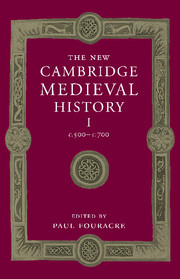Book contents
- Frontmatter
- Introduction: the history of Europe 500–700
- 1 The later Roman Empire
- 2 The Barbarian invasions
- 3 The sources and their interpretation
- PART I THE SIXTH CENTURY
- PART II THE SEVENTH CENTURY
- PART III THEMES AND PROBLEMS
- 20 The Jews in Europe 500–1050
- 21 Kings and kingship
- 22 The Mediterranean economy
- 23 The Northern Seas (fifth to eighth centuries)
- 24 Money and coinage
- 25 Church structure and organisation
- 26 Christianisation and the dissemination of Christian teaching
- 27 Education and learning
- 28A Art and architecture of western Europe
- 28B Art and architecture: the East
- List of Primary sources
- Bibliography of secondary works arranged by chapter
- Index
- Frontispiece"
- Plate section"
- Map 3 Gaul/Francia in the sixth and seventh centuries"
- References
28A - Art and architecture of western Europe
from PART III - THEMES AND PROBLEMS
Published online by Cambridge University Press: 28 March 2008
- Frontmatter
- Introduction: the history of Europe 500–700
- 1 The later Roman Empire
- 2 The Barbarian invasions
- 3 The sources and their interpretation
- PART I THE SIXTH CENTURY
- PART II THE SEVENTH CENTURY
- PART III THEMES AND PROBLEMS
- 20 The Jews in Europe 500–1050
- 21 Kings and kingship
- 22 The Mediterranean economy
- 23 The Northern Seas (fifth to eighth centuries)
- 24 Money and coinage
- 25 Church structure and organisation
- 26 Christianisation and the dissemination of Christian teaching
- 27 Education and learning
- 28A Art and architecture of western Europe
- 28B Art and architecture: the East
- List of Primary sources
- Bibliography of secondary works arranged by chapter
- Index
- Frontispiece"
- Plate section"
- Map 3 Gaul/Francia in the sixth and seventh centuries"
- References
Summary
The end of the West Roman Empire led to the fracturing of western Europe into a host of sub-Roman states. The new masters of what had been the west Roman provinces were for the most part Germanic war-leaders, although in the western parts of Britain there was a resurgence of Celtic power, while Ireland and much of Scotland had never been subject to Rome. The emergence of Germanic, and the development of Celtic kingdoms introduced or at least gave greater prominence to non-Roman artistic traditions, especially in metalwork and subsequently in manuscript illumination. At the same time Roman cultural traditions did continue, and indeed develop, and not only in those parts of the West which were reconquered by the Byzantines, like Ostrogothic Italy. The barbarian kingdoms of the West modelled themselves in many respects on the Roman Empire, and this modelling included the acquisition of Roman objects and the commissioning of objects in Roman style. Yet the desire to ape Rome was not strong enough to create anything like a unified artistic culture.
Neither did the growing uniformity of religious belief create such a culture, even though Christianity gave the West a single religion, a common set of religious practices (for instance in the liturgy and pilgrimage), and, perhaps, a more unified exegetical position for understanding art. Individual scenes from the Bible were depicted time and again. Furthermore, the leading saints of the church were provided with a recognisable iconography, making them an identifiable presence in much of the post-Roman West.
Keywords
- Type
- Chapter
- Information
- The New Cambridge Medieval History , pp. 760 - 775Publisher: Cambridge University PressPrint publication year: 2005



